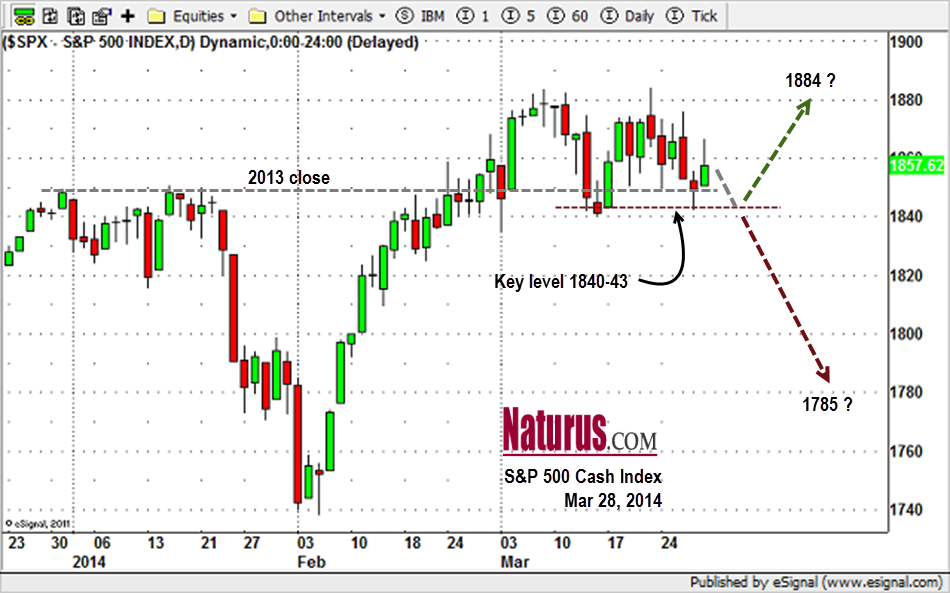Today, Monday March 31, is the last day of Quarter 1, 2014. Hurray! It is ending not a moment too soon.
After the smoking rally that was 2013, it has been a go-nowhere-do-nothing market for the first three months of this year: down in January, up in February, sideways in March. (See chart).
At the close on Friday the overall market, as measured by the S&P 500 (SPX), was up 1% for the year. By the close of trading on Monday, it could well be less. It has been a choppy, directionless market, painful for both short-term traders and investors alike.
As always, the question is: What happens next? Can we look forward to Q2 with hope in our hearts and enthusiasm for a bright new beginning?
Maybe not so much. April is historically the best month of the year for the equity market. But this year may be different, because:
THIS IS AN OLD BULL
Not as old as some, but this bull market is getting long in the tooth. In rough numbers, it has been running 60 months, and the market is up about 185% in that time.
According to the standard public database (Shiller) there have been 7 bull markets (including this one) since the end of WWII; 4 have been longer (the average is 104 months) and the average increase is 285%.
By that standard we may have a way to go. But while we know how far we have come, we don’t know how much longer it can go on. And it is definitely looking shaky, because:
THE FED IS BALKING
The main force moving this bull forward is the Federal Reserve’s Quantitative Easing program which at one stage was pumping close to $1 trillion – yes trillion – into the economy every year, with a large percentage of that ending up in the stock market. The market, not surprisingly, responded by going up. And up. And UP!
Now the Fed is cutting back to a more modest (!) $55 billion a month (from the previous nominal $85 billion per month) and has threatened to “taper” even more in the spring.
It remains to be seen if they will actually do it. A lot of “smart money” is betting that any serious decline in the stock market will bring the Fed scrambling back in to bail out Wall Street yet again. After all, they’ve done it before.
The SPX is already over-valued by more than 50% according to the Shiller Cape price/earnings ratio. (The long-term average ratio is around 16; we are currently around 25). It is always possible for the market to become even more overbought and over-valued. But the prudent stance here is to be prepared for a decent correction sooner rather than later.
So if the Fed sticks to the plan, the bull is likely to die on its feet. If they return to QE – perhaps with a new name, perhaps without making it public – the bull will run on. Nothing hoists the market like a few more billions in public money every month.
And there is an election this year.
THE SHORT-TERM OUTLOOK
For the short-term direction, watch how the market behaves at 1840-43 in the SPX. That will probably indicate the market’s next move.
The 1843 level is the key line for the cash index. A break below that level could lead the market down to challenge the March low (1834) or break lower toward 1785.
If on Monday the index closes the quarter below 1840 – an important stop-loss area – we may see a 10% or 20% correction in the following months. The long-term major supports are lying at 1756, 1650 and 1515.
But if SPX can manage to hold above the 1840 level, and/or move to the 1870 level, it could go back up to retest 1884.
We are still short-term bears, long-term bulls; this week we will be looking for a nice bounce to go short.





